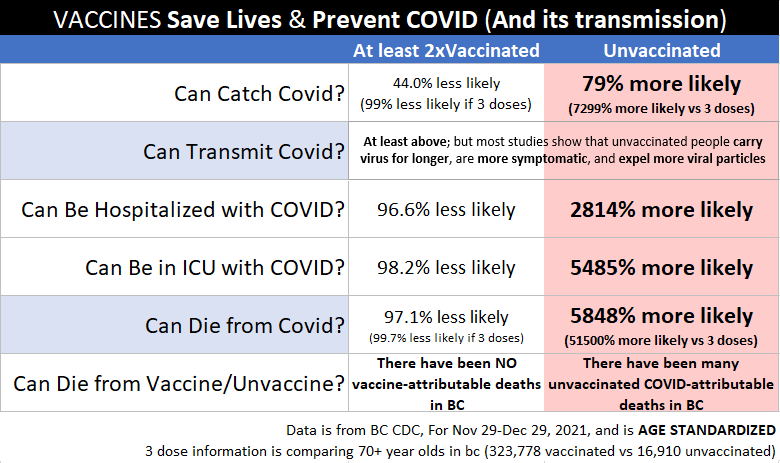
Good news from Ontario - the omicron "vaccine hole" seems to have a ceiling that's holding. There is still mild protection from vaccine, whereas ICU/hospitalization remains robust. (Updated today)
Suspect a portion is due to "who goes for tests."
/1
Suspect a portion is due to "who goes for tests."
/1

In BC, the variable of age plays large into the seemingly negative vaccine effectiveness. Age is such a massive variable that age standardization flips whether or not vaccines show effectiveness to reducing cases.
/2
/2

While the monthly stats still look quite vaccine-protective, this is shifting rapidly and the past few days have seen higher rates of vaccine cases than unvax cases.
/3
/3

Recent days have a blip where it appears that being vaccinated leads to a higher rate of infection than being infected.
I am sure this type of bias has a name (blanking on it), the "time window" bias. When our time frame is 1 day, yes, we see this.
/4
I am sure this type of bias has a name (blanking on it), the "time window" bias. When our time frame is 1 day, yes, we see this.
/4

To show you why the story isn't as bleak as this graph suggests, let's recreate the graph in excel (AHHH @bccdc i had to type this in by hand it was soooooo annoying please let us download data!!! :) )
Here it is: July 1 2021 to Jan 3, 2022
/5
Here it is: July 1 2021 to Jan 3, 2022
/5

Now, lets change this to cumulative case rate.
I personally think that it is very unlikely that vaccinated case rates will overtake unvaccinated case rates, knowing that our vaccines ARE protective and have efficacy (Even waning) against Omicron.
/6
I personally think that it is very unlikely that vaccinated case rates will overtake unvaccinated case rates, knowing that our vaccines ARE protective and have efficacy (Even waning) against Omicron.
/6

So likely, we will continue to see a dramatically lower (but positive) efficacy of vaccines than we're used to. We will see many more vaccinated cases of covid.
But vaccines still are preventative of infection overall, definitely remain protective of hospitalization & death.
/7
But vaccines still are preventative of infection overall, definitely remain protective of hospitalization & death.
/7
This effect is statistically very nunaced, so media people, please consult with statisticians! Don't look at the charts yourself!
a) vaccinated people and unvaccinated get TESTED at different rates
b) unvaccinated people have a much higher cumulative rate
/8
a) vaccinated people and unvaccinated get TESTED at different rates
b) unvaccinated people have a much higher cumulative rate
/8
c) omicron reduces VE, so we will see more vaccinated people get covid
Good luck as we enter THIS murky phase.
Good luck as we enter THIS murky phase.
both need to be taken together and understood in both the large context of vaccination, as well as what will happen when a "breakthrough variant" (with a lower VE) establishes dominance. We will see this shift.
• • •
Missing some Tweet in this thread? You can try to
force a refresh












